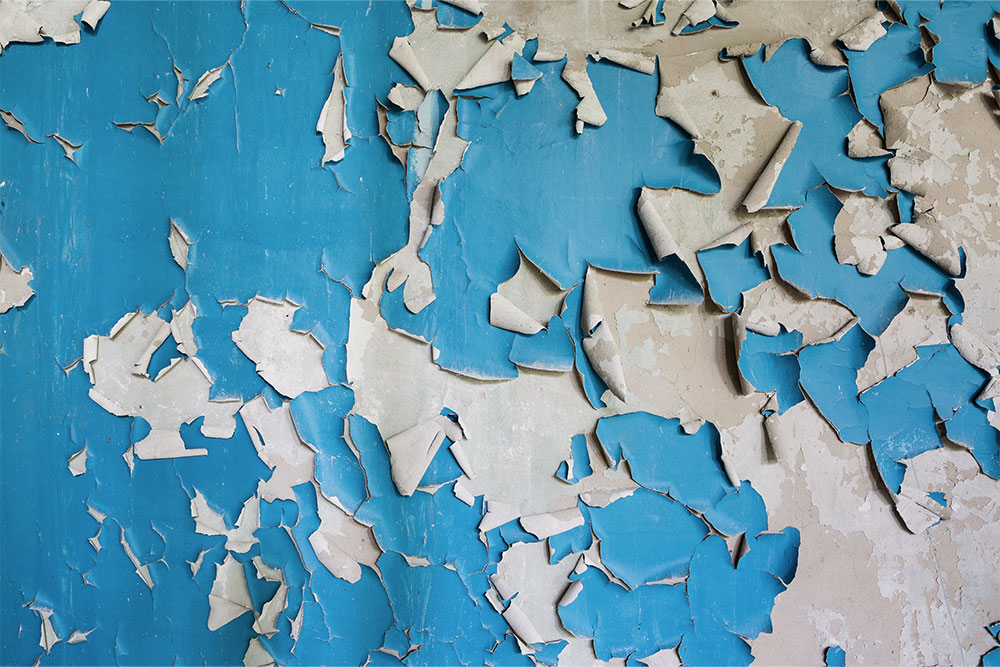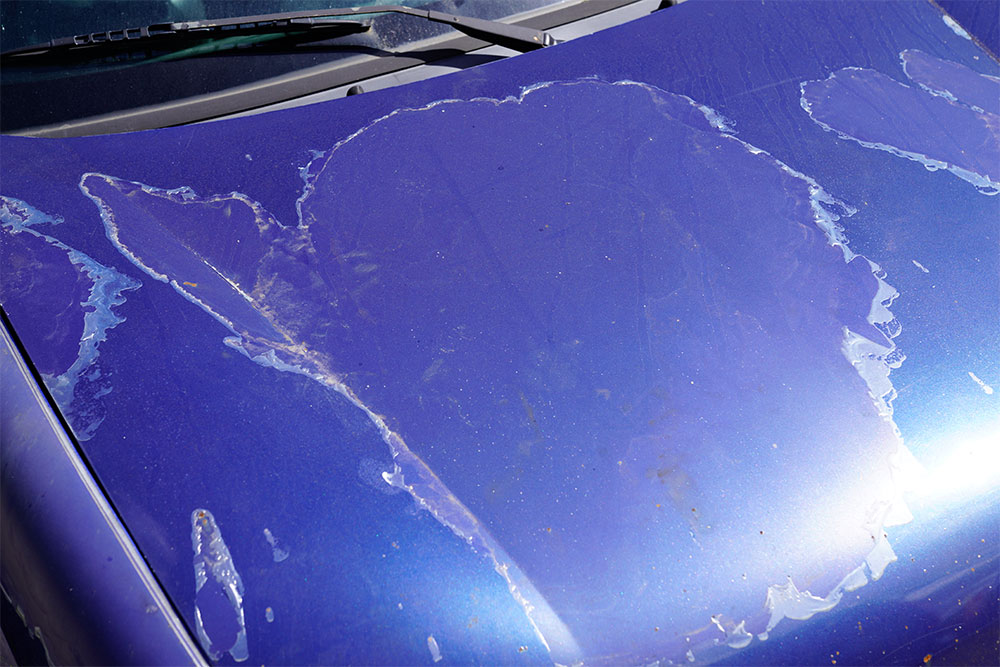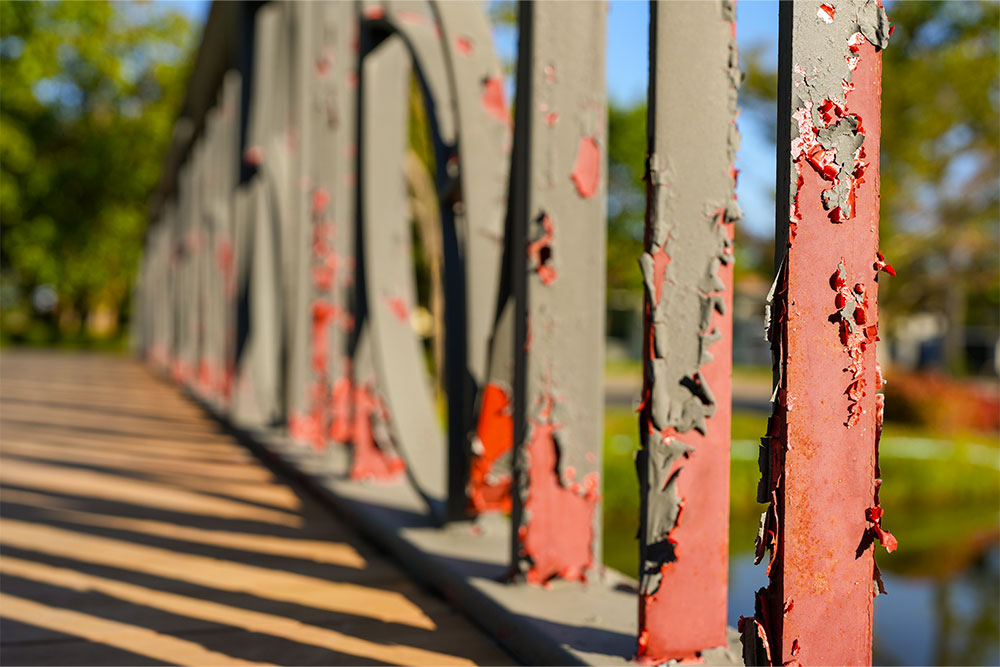Whether on metal, plastic, wood, or concrete, one of the most common paint defects is peeling. Just as skin flakes off after a sunburn, so do some coated surfaces, more or less severely. In this article, we will take a closer look at the causes of this phenomenon and the ways to avoid it and we will analyse some examples of paint failures due to peeling after a fairly long period of time after application, including a topical story.
Peeling is one of the (few) coating defects calling for a heavy corrective intervention, consisting in completely removing the paint film and repainting afterwards. Also known as chipping or flaking (in the case of a harder and, consequently, more brittle coating), it causes the paint layer to lift off the surface, resulting in the inevitable rupture of the film and the exposure of the substrate to external agents, thus increasing the risk of corrosion initiation for metals and rapid deterioration for wood. Clear coat peeling off car bodies, leaving the underlying layer of paint exposed and therefore losing its protective function, also falls within the scope of this coating failure.
Why does paint peel off substrates?
In 90% of cases, peeling is due to inadequate surface preparation prior to painting or to the use of unsuitable cleaning products. The presence of residues during chemical or mechanical pre-treatment certainly causes critical issues in terms of coating adhesion.
A few further possible causes are related the environmental conditions in which work is carried out: too low or too high a temperature during application, for example, can contribute to inadequate paint adhesion. A high moisture content on the substrate or among layers can also reduce application effectiveness.
In the case of multiple coats, finally, using a primer that is too dry reduces adhesion of the subsequently added layer, so that the coating may begin to flake off right after the end of the painting process.
 © AdobeStock
© AdobeStockLiquid paint peeling off
In the case of liquid coatings, flaking can be caused by the loss of adhesion of the paint layer to the underlying surface. This can be due to various factors, including substrate contamination due to the presence of wax, grease, silicone, oil, release agents, water, rust, or soap and the wrong use or non-use of a metal lubricant on steel or aluminium surfaces. Both of these errors lead to the paint not adhering to the surface.
During the application phase, temperature that is too high or too low, an incorrect base coat application procedure, or a base coat that is not completely dry can also compromise the final result. Other causes include inadequate paint viscosity, the use of an improper or poor-quality thinner, excessive air pressure, excessive paint layer thickness, and tension between two adjacent coats.
How do you prevent peeling of liquid paint?
“Better safe than sorry”: this popular motto also applies to industrial coating. So, here are some useful tips for preventing flaking of liquid paint.
First of all, one should make sure that the surfaces are perfectly clean and that the products used for pre-treatment (e.g. lubricants, in the case of metals) are suitable for the substrate’s material. Applying the required coating promptly, without allowing too much time to elapse after preparation, is another measure to avoid rust formation in the case of metals. It is also important to carefully check the temperatures of the drying surface and of the oven. In addition, the base coat should be completely dry before the next coat of paint is applied. It is also necessary to apply thin layers, avoiding excessive thicknesses. Finally, during the dilution phase, the paint product should reach the right viscosity: this is why choosing the right thinner is crucial. Minimising compressed air through proper atomisation also plays a strategic role.
As mentioned above, if paint peels, the only solution for restoring the coating is to completely strip the surface, prepare it again, and repaint it.
Automotive clear coat peeling off
A defect that emerges after a longer or shorter period after the paint has been applied is the peeling of clear coats off car bodies – a very popular topic on the web! This phenomenon can still be seen on older cars today, as the development of increasingly high-performance paints and clear coats in recent years has enabled the automotive industry to significantly reduce the number of vehicles with flaking body parts.
 © AdobeStock
© AdobeStockWhat is it caused by? Flaking clear coats can be due to incorrect substrate preparation or, above all, to the cars’ exposure to the most aggressive atmospheric agents, such as sun, rain, or even salt and temperature changes. Frequent and continued contact with the sun’s rays causes them to penetrate through the clear coat and begin to attack the bond between the underlying colour layer and the clear coat itself applied on top. This is due to the fact that body parts subjected to hot and cold temperature fluctuations expand and contract slightly: in the long term, the clear coat loses some of its elasticity and starts to crack, it lifts, and it loses its protective power, leaving the colour layer exposed.
Again, to restore the clear coat, it is necessary to completely remove it from the car body, carefully sand the surface, and then reapply the top coat layer.
Powder coating peeling off
In the field of powder coating as well, a film peeling off the underlying substrate (which is usually hot-dip galvanised) is an increasingly rare phenomenon, because experience and technological developments have allowed solving many of the issues possibly causing it. However, it can still happen to see railings, metal fences, parapets (even of recent construction), garage gates, gutters, and downpipes with chipped paint.
 © AdobeStock
© AdobeStockThis happens for three main reasons:
- inadequate substrate preparation
- use of unsuitable products
- incorrect application.
As already repeated several times in this article, proper preparation of the substrate before painting is essential to avoid failures. Already at the outset, surfaces should be free of defects and residues of dirt, such as oil and grease. Therefore, it is necessary to thoroughly clean them and make sure they are pristine and moisture-fee after drying. Until a few years ago, much of the most common damage suffered by powder coatings applied to galvanised substrates was due to the use of improper paints, with properties unsuitable for outdoor exposure in harsh weather or particularly humid conditions. This results in poor adhesion and severe embrittlement of the film. As a general guideline, paints containing drying oils or synthetic resins modified with drying oils and fatty acids are not recommended for outdoor use. It has been known for many years that the most suitable product for this type of applications are two-component powder systems (e.g. epoxy primers and polyurethane finishes). However, even when using the most suitable paint products, it should be emphasised once again that failure can still occur if pre-treatment is not adequate and if the paint application operation is not carried out properly.
Paint peeling off plastics
Flaking of a coating applied on a plastic substrate can be caused by failure to remove the release agents used in the moulding process, insufficient cleaning or sanding of the plastic surface, the use of unsuitable cleaning agents or degreasers, failure to heat the plastic parts before painting, or the use of a plastic substrate that is incompatible with the coating. This is why the polymer’s properties should always be checked before application. Other precautions include adequately cleaning the plastic substrate with suitable detergents both before and after sanding and using suitable products for sanding. In order to remove any release agent residues from the substrate, the parts should be heated for at least 1 hour at a maximum temperature of 60 °C. In particular, microporous plastics (e.g. PU) should be dried before coating, as some release agents may have penetrated the micropores during the production process. Surfaces should be cleaned with suitable products both before and after heating.
A peculiar case
The dispute that began in May 2021 between Qatar Airways and Airbus over peeling paint on certain surface areas of some A350 airliners was recently concluded with an amicable settlement. The airline had asked Airbus to strip and repaint some of its fleet aircraft with a special livery to celebrate the 2022 FIFA World Cup.
 © AEROExpo
© AEROExpoFor the construction of these airplanes, Airbus had decided to use carbon fibre instead of metal in order to reduce their weight and lower fuel consumption. Carbon fibre, besides being a more difficult material to deal with in terms of paint adhesion, is not conductive and, therefore, these jets also need a layer of wire mesh to dissipate lightning. Another factor to be taken into account is the fact that carbon fibre does not expand and shrink with temperature changes, as paint does: this may have been the cause of the flaking of paint over time. Exclusive photos taken by Reuters show an exposed and corroded lightning conductor under chipping paint. In its statement, however, Airbus emphasised that “the surface paint-related findings have been thoroughly assessed by Airbus and confirmed by the European Aviation Safety Agency (EASA) as having no airworthiness impact on the A350 fleet”. While waiting to find out more details about the resolution of the dispute between these two aviation giants, we would like to reiterate once again the importance of carefully analysing the characteristics of each painting task before starting, studying in depth the peculiarities of the material to be coated and of the paints to be used, preparing the substrates (from the railing of one’s balcony to a car, up to the livery of an aircraft) in the most appropriate way prior to coating, and using the most suitable products and equipment for this purpose.
To keep up to date with the latest product innovations in the field of surface treatments, read our magazines.